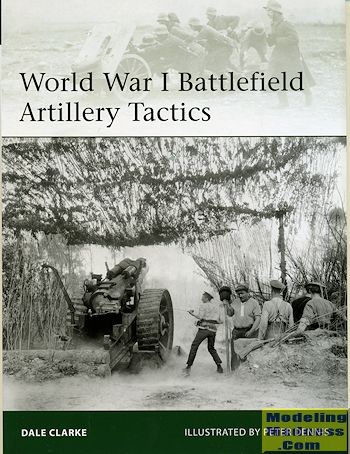 In
common with many who are not enthusiasts of the subject, I have always looked at
artillery as being little more than a way of either killing a lot of people or
digging large holes in the ground. It is, of course, those and more. There is a
science to using it and this science underwent a major change during the 'War to
End All Wars'.
In
common with many who are not enthusiasts of the subject, I have always looked at
artillery as being little more than a way of either killing a lot of people or
digging large holes in the ground. It is, of course, those and more. There is a
science to using it and this science underwent a major change during the 'War to
End All Wars'.
Its initial use was against massed armies. Prior to
WWI, opposing armies would line up against each other and it was against this
background that artillery would be used to cut swaths through the ranks. Larger
artillery was used to knock down defenses in much the same way that catapults
were used prior to the introduction of the canon.
However, during the first year of WWI, movement of
armies in the field ground to a halt as both sides dug into defensive positions.
The early culmination of the war did not happen and both sides needed time to
regroup (funny how that always seems to happen in wars, yet neither combatant
seems to be truly prepared for it, even today).
This meant a change in how the war was waged. With
the loss of maneuver combat, it turned into a slug-fest. Both sides felt that
more guns meant that more destruction could be poured down on the enemy,
destroying his defensive works, killing his troops and even destroying his
artillery by counter-battery fire.
The British, who were woefully unprepared for a
major war, took years to finally provide the numbers in terms of guns and
ammunition that was needed as major campaigns used literally millions of shells.
One thing they did develop was a 'walking bombardment', which used artillery to
clear the path for troops. Unfortunately, they took a while to get it right and
friendly fire deaths were considerable. The British also developed improving
ways of detecting the position of German guns via triangulating gun flashes or
even the sound of the guns and through aerial reconnaissance. They even worked
on figuring precise figures on how far a shot would go taking into account
winds, pressure, the sort of powder used in the shell and the newness of the gun
barrel, something the Germans never really paid a lot of attention to.
On both sides, troops worked out methods of
surviving these barrages by digging deep bunkers, or retreating back once the
barrage, which frequently lasted many days, commenced. This was countered by
using box barrages which cut off their retreat to the rear and also prevented
side movements.
Meanwhile the Germans had come up with some of
their own tactics that proved extremely successful on the Eastern Front and were
directly responsible for their win over the Russians. Artillery enthusiasts will
know the name of Georg Bruchmueller, who was responsible for many of the
innovations used by the German army in the last two years of the war.
There is, of course, a lot more in the book as well
as aspects not covered in this review. To the uninitiated, it is a real
eye-opener and an excellent reference on the use of artillery and how it changed
during the war. To the enthusiast, it will provide an excellent reference. The
author uses a number of battles as examples throughout the book and his writing
style is such that it is a pleasure to read. It is a book that I know you will
enjoy reading as well.
March 2015
For more on the complete line of Osprey books,
visit http://ospreygrp.com. In the US, it is
Osprey Direct at 443 Park Avenue South, New York, NY 10016, where you can
get a catalogue of available books.
If you would like your product reviewed fairly and
fairly quickly, please contact
the editor or see other details in the Note to
Contributors.
 In
common with many who are not enthusiasts of the subject, I have always looked at
artillery as being little more than a way of either killing a lot of people or
digging large holes in the ground. It is, of course, those and more. There is a
science to using it and this science underwent a major change during the 'War to
End All Wars'.
In
common with many who are not enthusiasts of the subject, I have always looked at
artillery as being little more than a way of either killing a lot of people or
digging large holes in the ground. It is, of course, those and more. There is a
science to using it and this science underwent a major change during the 'War to
End All Wars'.